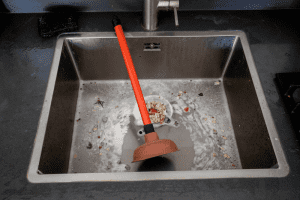You’ve made it to the store, you’re ready to renovate your bathroom or kitchen, and you’re considering which ones are better, Schluter or Bullnose? No need to worry.
In this article, we will provide detailed information comparing both types in terms of design, aesthetics, installation, durability, cost, protection, and application.
What is Schluter?
Schluter refers to a metal or plastic strip installed on the edge of tiled walls and floors for a finished look and edge protection. Named after its brand, Schluter Systems, these profiles are renowned for their durability and versatility.
Additionally, these types offer a variety of profiles such as the Jolly, Quadec, and Rondec, each serving different purposes and styles.
Pros
- Modern Look: Schluter trims offer a sleek and contemporary aesthetic. It’s suitable for current design trends.
- Durability: These types are reputed for their robustness and ability to withstand wear and tear, offering a long-lasting solution for tile edges.
- Edge Protection: One of their primary functions is to protect tile edges, reducing the risk of chipping or damage over time.
- Variety: Schluter comes in a variety of finishes and styles, allowing you to match the rest of your design style.
Cons
- Installation: Schluter strips can be somewhat tricky to install. This might require professional help.
- Cost: Depending on the type of Schluter strip, they can be more expensive than traditional bullnose tiles, particularly if opting for high-end metal finishes.
- Compatibility: These strips may not blend as seamlessly with traditional or rustic decor styles due to their modern, clean-lined appearance.

What is Bullnose?
Bullnose tiles are specially designed tiles with a rounded or curved edge. They’re traditionally used as a finishing touch on tiled walls, countertops, and flooring, giving a smooth, elegant transition.
Furthermore, these tiles come in various forms, including single bullnose (one rounded edge), double bullnose (two rounded edges), and corner bullnose (rounded at the corner).
Pros
- Classic look: Bullnose tiles give a smooth, rounded finish that blends nicely with your other ones. So, it brings a classic and harmonious look to your home style.
- Easy to install: These tiles are pretty easy to put in place. This makes them a good choice for those who want to do it on their own or who have a limited budget.
- Less expensive: Generally, Bullnose tiles are cheaper than Schluter. So it’s suitable for those who are considering their budget.
Cons
- Limited styles: Sometimes, you might not find Bullnose tiles that match the style or color of your chosen tile. This could limit how you can use them in your design.
- Protection: These tiles don’t provide as much protection to your tile edges. If your space gets a lot of foot traffic or use, your tiles might wear out quicker.

Read more: Framed vs Frameless Cabinets: 7 Key Differences
Comparing Schluter and Bullnose
Here, we give you key features to help you distinguish both types:
Design
The design distinction between Schluter and Bullnose hinges on their shape and utility. And this will depend on your home style and personal preference. Schluter, marked by its sleek lines and modern aesthetic, fits perfectly into spaces favoring a clean and minimalist style. Its straight, well-defined edges deliver a sharp and tidy look. So it’s suitable for a modern home style.
In contrast, Bullnose, known for its smooth, rounded edges, adds a touch of classic and timeless charm. It’s an excellent choice for spaces seeking a warm, homey vibe. The gently rounded contours of these tiles bring you an organic, flowing feel. So it helps soften and enhance the overall appeal of your space.
Beyond just looks, Schluter types carry practical benefits as well. For example, Schluter can smoothly transition between different flooring types such as carpet and tile, or protect exposed tile edges. Typically made of metal or plastic, Schluter stands apart from Bullnose tiles. Meanwhile, Bullnose, usually crafted from the same material as the adjacent tiles, is primarily used for its decorative allure.
Installation process
When discussing installation, Bullnose tiles generally offer a simpler experience than Schluter strips. It’s pretty much like fitting standard tiles – all you need to do is glue them to the wall using tile adhesive. This easy method makes these tiles a preferred choice for those wanting to do it yourself.
Besides, installing Schluter types might be a bit more challenging and might require some level of expertise. The procedure is not too complex, but it does involve sticking the Schluter strip to the tile’s edge using a particular adhesive and then setting the tile into the mortar. This process might appear a bit daunting for beginners, but with a little bit of patience and practice, it’s entirely doable.
Durability
Both types deliver impressive durability, but Schluter is particularly renowned for their ability to resist wear and damage. These metal strips are strong and hard-wearing, ensuring a longer lifespan for your tile edges. This makes them ideal for areas with heavy footfall that require additional robustness.
On the other hand, Bullnose tiles are also durable, but they’re slightly less durable than Schluter. Because they may be prone to chipping at the edges due to their curved shape. So, regular maintenance, including cleaning and sealing, can help last your Bullnose tiles and keep them looking their best.
Protection
In terms of protection, Schluter systems stand out for their superior edge-safeguarding capabilities. They are expertly designed to shield your tiles from chipping and cracking, ensuring they retain their looks and function for a longer time. While Bullnose tiles also offer some degree of edge protection, they are mainly used for their aesthetic appeal.
Where it is used
When it comes to their application, Schluter and Bullnose have a high level of versatility. You can use them in a variety of places within your home, including tiled walls, countertops, and floors.
For example, if you want your home style to follow modern styles, a clean-lined look. Additionally, if you are concerned about the areas with many people passing away that leads to damage. So, Schluter might be your best choice.
Alternatively, if your preference leans towards a gentler, more classic aesthetic, Bullnose tiles would certainly be a fitting selection. They offer a traditional appeal that can soften the overall appearance of a room.
Remember, the choice between these types should depend on your design preferences and specific requirements.

Cost
Bullnose tiles are typically cheaper than Schluter ones. However, the cost of Schluter systems varies widely depending on the specific model and finish chosen.
Read more: How to Fill Gap Between Kitchen Sink and Granite?
Schluter vs Bullnose – Which is Better
There’s no definitive answer to this as it heavily depends on your personal preference, the design of your space, and your budget. If you prefer a modern look and superior edge protection, Schluter might be the way to go. But if you’re after a traditional, seamless aesthetic and a simpler installation process, Bullnose tiles might be your best choice.
Conclusion
Both Schluter vs Bullnose have their pros and cons. Your choice between the two should be based on your design preference, budget, and installation comfort level. No matter what you choose, both options will help you create a beautiful and finished look for your tiled spaces.
FAQs
Jolly trim adjusts better to varying tile thicknesses. Traditionally, Bullnose has been the preferred choice for tile edging. However, Bullnose doesn’t provide the same adaptability as Jolly, especially with larger or linear tile formats. No matter the tile type you choose, Jolly gives a sleek, thin border around your tile installation.
To choose tile edging, you measure the length of your tiles. Then, divide that measurement by the width of the trim. This will give you the correct size of edging needed for your installation. Make sure the trim is neither too big nor too small compared to your tiles for a smooth look.
Schluter offers a variety of finishes and sizes, providing a modern and minimalist aesthetic. Bullnose tiles offer a traditional and seamless look, especially when matched with the other tiles.




